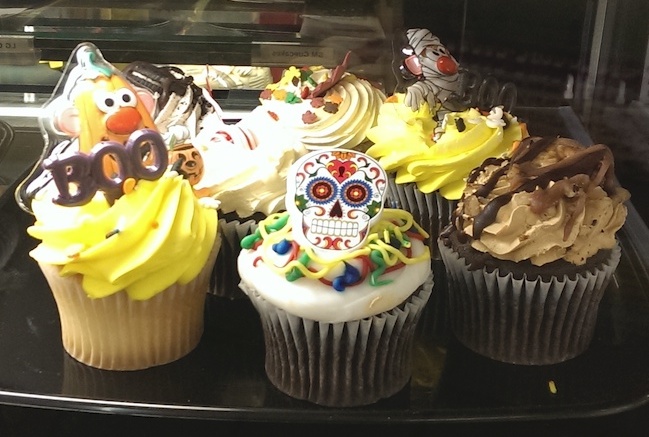History
Soul day, Soul day,
We be come a-souling.
Pray good people remember the poor,
And give us a soul cake.
One for Peter, two for Paul,
Three for Him that made us all
An apple, a pear, a plum or a cherry
Or any good thing to make us merry.
-- from Poole, Customs, Superstitions, and Legends of Staffordshire, quoted in Halloween: An American Holiday, an American Tradition by Lesley Pratt Bannatyne.
Although Halloween's origins begin with the Celtic holiday of Samhain, the holiday as we now celebrate it was also influenced by the Roman festival of Pomona and the teachings of the early Christian church (Bannatyne, Halloween, pp. 1-2). Halloween lost favor in many parts of Europe after the Reformation, but it found new life in America, becoming largely an American holiday. There are related holidays celebrated elsewhere in the world. From the Victorian Era through the Twentieth Century, Halloween has grown in popularity, becoming a favorite holiday both of adults and children in modern times.
Before Halloween became a secular holiday mostly associated with candy and costumes, it was a seasonal festival with religious overtones, and in some respects, it continues to be so today. Halloween is part indulgent feast, part fear of the unknown, a time when imaginations run wild, and a time when we remember the past, consider the future, and celebrate the idea that those who love us never really leave us.
Samhain
Samhain is pronouned "sow-an" and means "summer's end." Although the exact details of what happened on this ancient holiday are uncertain, it is generally known to be a celebration of the changing of the seasons, from summer to winter (Rogers 11). The Celts who lived in the British Isles and northern Europe long before the beginning of Christianity made their living by hunting and herding animals. There were two main seasons for the Celts, winter and summer, which each lasted about six months. During the summer, they would let their herds roam the pastures and multiply. When winter began, they would have to thin the herds when they brought the animals in to shelter. They would shelter the animals that would make the best breeders, and the rest would become food (Bannatyne, Halloween, p. 2).
Because the changing of the season from summer to winter was marked with a slaughter of animals for food, it was also marked with a feast because there was plenty for everyone to eat (Bannatyne, Halloween, p. 2). But, the holiday wasn't just about celebrating the end of the grazing period and the bounty of food. It was also the beginning of a new year. It was a time to finish the business of the old year and prepare for the next, paying debts, buying and selling livestock, completing land purchases or renewing rents. At the same time, it seemed that the Celts used Samhain as a time for remembering their ancestors (Bannatyne, Halloween, p. 4). Some of what follows is a combination of folklore and historical detective work because the Celts themselves left no written records of this holiday or their intentions regarding it. Most of what we know comes from other sources.
As Nicholas Rogers says in his book Halloween: From Pagan Ritual to Party Night, "there is no hard evidence that Samhain was specifically devoted to the dead or to ancestor worship, despite claims to the contrary by some American folklorists, some of whom have presumed that the feast was devoted to Saman, god of the dead." It is possible that some of the beliefs about how Celts viewed the connection between the dead and Samhain might be projections from more modern people whose views are influenced by the traditions of All Souls' Day. However, there were connections to the supernatural. In ancient Irish sagas, there are references to Samhain as a time when people would pay tribute to conquerers. They also refer to the appearance of mythical people, the sidh, who might allow mortals to see the palaces where the gods of the underworld live at Samhain. Winter for the Celts was a time of darkness, "nature is asleep, summer has returned to the underworld, and the earth is desolate and inhospitable." It was a time associated with story-telling and prophecy (Rogers 19-20).

In that sense, people are correct to say that Samhain was a sacred festival, celebrating not only the transition of seasons but the link between the past and the present, the living and the dead. With the onset of winter, days became shorter, and nights became longer. The Celts believed that the spirits of the dead would walk once more among the living on the night of Samhain, along with demons and other spirits. It was frightening, but also a time when they could try to understand the unknowable, seek answers to the questions that most worried them, and to consider one more important link in life's chain: the link between themselves, their past, and their future (Bannatyne, Halloween, pp. 2, 4).
The Celtic religion was headed by priests called Druids, and they believed in a form of sympathetic magic. They believed that the spirits of their ancestors who had died and gone on to the afterlife had learned many secrets, including knowledge of what was going to happen to their living relatives in the future. The Druids believed that their ability to prophesy the future was stronger at Samhain because of the presence of these spirits, and they would try to read omens that would tell them what the best choice would be in any decisions that had to be made, how they might cure a sickness that was troubling their tribe, and what lay ahead for their tribe's welfare in general (Bannatyne, Halloween, pp. 2, 4).
Some of these divinations may have involved human and animal sacrifice, but it's difficult to say for sure because the sources that discuss it are not first hand accounts. Most of the evidence concerning these sacrifices comes from classical authors such as Strabo, Diodorus, and Julius Caesar, and they were writing more general pieces criticizing the superstitions and rituals of people they considered "barbarous," nothing that described Samhain in particular (Rogers 13-14). Early Irish sagas make only brief references to sacrifices, but it's difficult to say how the versions that have been written down differ from the original oral tales. There is physical evidence that Celtic warriors kept the skulls of enemies, but their motives for doing that are unknown. These heads might have been battle trophies or some kind of religious offering. Archaeologists uncovered another site in County Meath, Ireland, that contained pits of human and animal bones, which suggest possible sacrifices, but there is still nothing that firmly ties sacrifices to the holiday of Samhain (Rogers 18-19).
Although the presence of the spirits, especially the demons that might be abroad, was frightening, the idea that loved ones weren't completely gone, that they might return for a brief visit once a year was also welcoming and comforting. Celts would provide food and drink and a place at the hearth for these weary spiritual travelers to welcome them home. To keep the scary spirits away, they would disguise themselves so that demons might mistake them for other demons and leave them alone. Villages would come together, and community members wearing masks meant to disguise themselves as spirits would lead a parade to the edge of town in the hopes that the real spirits would join in and then move on, leaving the villagers in peace (Bannatyne, Halloween, p. 4).
The original traditions of Samhain formed the main basis of modern Halloween traditions: a belief that scary things walk the night, offerings of food, members of the community parading around in costumes, etc. But, it would take other influences before Samhain would finish its transformation into the holiday that we know as Halloween.
To Top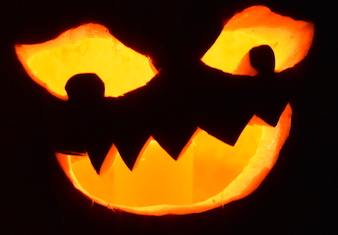
Pomona
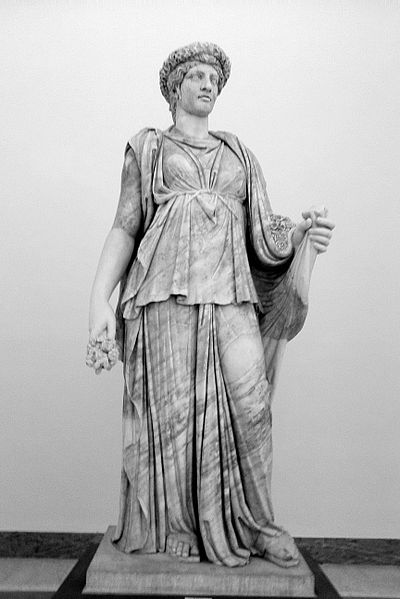
From Wikimedia Commons
Eventually, the Roman Empire expanded its territories, conquering northern Europe and the British Isles, bringing the Celtic people under their control. By the 1st century AD, Romans had already joined Celtic communities, and the two groups lived as one. When that happened, aspects of Roman culture and religion were transferred to the Celts, blending in with their existing traditions and creating a new culture that they both shared (Bannatyne, Halloween, p. 7).
The Romans were a more agrarian society than the Celts, and their autumn holiday focused more on the harvesting of plants than the thinning of livestock. November 1st was the festival of Pomona, the goddess of harvests. In Roman mythology, Pomona was a nymph who loved caring for orchards and completely ignored all the male divinities who adored her until Vertumnus, the god of the changing seasons, convinced her of his love. Ond day, he disguised himself as an old woman so that he could give her a prophecy to change her mind about her solitary existence. In this disguise, he pointed out to her that a vine needs the support of a tree to grow upward and bear fruit, and so Pomona could not be at her best by remaining alone. Vertumnus told Pomona that he also shared her love of growing things and that, if she accepted his love for her, he would gladly share her work. Pomona did fall in love with Vertumnus when he shed his disguise, and the two of them worked the orchards together forever afterward (Bannatyne, Halloween, pp. 6-7).
By November 1, the Romans had already brought their harvest in from the orchards and fields, ready for winter. They held celebratory feasts that included foods associated with Pomona's orchards such as apples, nuts, and grapes. Because of the myth of Pomona, they thought of apples as symbols of fertility and love. Apples and nuts would later become staples of Halloween, and the divinations of Samhain turned into fortune-telling games that involved young people using apples and nuts to learn who they were going to marry. The night of spirits and harvest celebrations had aquired an aspect of romance (Bannatyne, Halloween, p. 6-7).
But, the story of Halloween doesn't stop here. A new religion had entered the Roman Empire, moving in from their Middle Eastern outposts. It was a strange mystery religion. Instead of the pantheon of gods that the Romans worshipped, there was only one single God that its adherants recognized. It was said that these people did not even fear death because their single, all-powerful God was the God both of the living and of the dead (the Romans, like the Greeks, Egyptians, and other polytheistic religions, had a separate god for the dead and for various aspects of life). It would take many years before these new beliefs would spread throughout the empire and reach its northernmost territories, but when they did, this harvest festival where the dead were remembered would take on a new form and a new meaning.
To TopAll Saints Day and All Souls Day
"Let the shrines of idols by no means be destroyed. Let water be consecrated and sprinkled in the temples, let altars be erected . . . so that the people, not seeing their temples destroyed, may displace error and recognize and adore the true God."
-- Pope Gregroy I, quoted in Halloween: An American Holiday, an American Tradition by Lesley Pratt Bannatyne.
The spread of Christianity throughout the Roman Empire and on to other territories took about 300 years. Eventually, it replaced the old polytheistic religion of the Romans. The Christians disdained the old pagan practices of the Romans and the Celts, but surprisingly, instead of trying to eliminate the holiday of Samhain/Pomona, they decided to use it for their own purposes. In the process, they ended up truly creating the holiday of Halloween and preserving it for well over a thousand years, to the present day (Bannatyne, Halloween, p. 8).
The reasoning of the early Christians was that if new converts were allowed to keep some of the old traditions that they loved and took comfort in, they would find it much easier to embrace the new beliefs of the religion they were being recruited to join. However, to make the holiday acceptable for the new Christians to celebrate, the Church had to change the people's intent behind the festivities to suit Christian ideals (Bannatyne, Halloween, p. 8).
November 1 became a day to honor saints under Pope Gregory III during the 8th century. Pope Boniface IV originally established a holiday to honor saints in the 7th century and set the date as May 13, the day when he dedicated the Pantheon (Rome's temple to the old gods) to St. Mary and the Martyrs. Pope Gregory III purposely changed the date of the holiday to November I to switch the focus of the pagan festival on that date to a more Christian theme. Because different churches in different areas were dedicated to different saints, Pope Gregory IV expanded the festivities by declaring that November 1 was a day to honor all saints. Thus, November 1 became All Saint's Day, a day of remembrance for every Christian saint (Bannatyne, Halloween, p. 9).
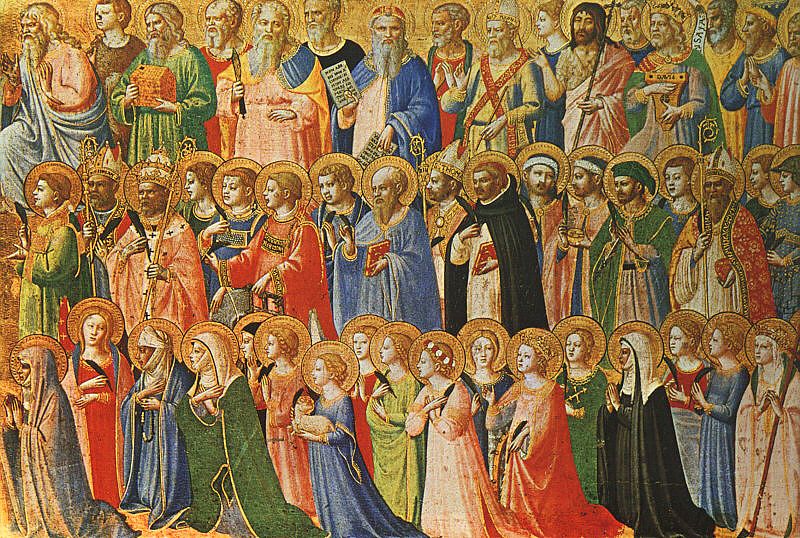
From Wikimedia Commons
People still wore costumes on All Saints' Day, but instead of dressing up as spirits to ward off demons, the priests encouraged people to dress in religious-themed costumes such as angels, devils, and saints, especially in small churches which had no holy relics to display in honor of their patron saints. The people still held parades, but now they were for the celebration of the saints. They lit bonfires as they always did, but the Church said that the fires were frightening away the devil (Bannatyne, Halloween, p. 9).
But, what about the remembrance of the ordinary people who had died, people who were not saints? During the 9th century, the holiday expanded with All Souls' Day, a day specifically to honor the souls of all the dead, not just the saints. In the late 10th century, Saint Odilo of Cluny, a Benedictine abbot, requested that the holiday become an official part of the the Church calendar, to be celebrated on November 2. Over the next 400 years, the practice spread throughout Europe (Bannatyne, Halloween, pp. 9, 11). Everywhere the Church went, the celebrations for both the Hallowed dead and ancestral dead went, too (Bannatyne, Halloween, p. 12).
By the end of the Middle Ages, All Saints' Day and All Souls' Day were important holy days of obligation on the Church calendar. Churches held high masses. Requim masses were meant to appease the dead and prevent hauntings. On the eve of All Souls' Day, they would ring bells for those who waited in purgatory, a sort of waiting room between heaven and hell. Sometimes, they would ring the bells all night long to drive away evil spirits (Rogers 23).

From Wikimedia Commons, CC BY-SA 4.0
Priests urged the members of their churches to bake small pastries and breads called "soul cakes." Instead of leaving out food for wandering spirits, people were supposed to give these soul cakes to poor people, and the poor people would repay their generosity by saying prayers for the dead. Besides encouraging the Christian value of charity and continuing to honor the memory of the dead through prayer, the practice of giving out soul cakes was supposed to steer people's minds away from pagan sacrifices and divination (although these aspects would remain in other forms). However, it wasn't just the poor who benefited from this practice. It became popular for boys and young men to visit to the houses of their neighbors on this day, although they often begged for food, drink, and coins instead of soul cakes. They would sing songs called "souling" songs as they made their rounds, a custom that would become the basis for modern trick-or-treating (Bannatyne, Halloween, p. 9, 12).
As to exactly what type of "cakes" these soul cakes were, they could vary greatly from one place to the next, depending on the tastes and habits of the people living there. For example, people in Yorkshire, England made dark fruitcakes that they called Saumas (soul mass) cakes. In Northhamptonshire, they made little buns coated in caraway seeds. People in Scotland made flat oat flour buns that they called Dirge Loaves (Morgan, p. 24). For example recipes for soul cakes that you can make at home, see the recipes section of the site.
In each place where the holiday was adopted, old traditions were given new twists. The concept of jack o'lanterns first appeared in the British Isles during the Middle Ages. People there carved lanterns out of turnips to scare away evil spirits. People in Spain baked and gave away pastries they called "bones of the holy" (remember that when you read about Dia de los Muertos). People everywhere visisted cemeteries, leaving gifts and candles (Bannatyne, Halloween, p. 12).
So, in the end, it was the Christians who ended up making Halloween really "Halloween," in a very literal sense. The word "Halloween" is actually a short name for "All Hallows Eve." All Saints' Day was called "All Hallows" during the Middle Ages. The night before All Saints' day, the evening of October 31, would then be "All Hallows Eve." This night continued to be used for part of its original purpose: as a time to remember the dead (Bannatyne, Halloween, p. 11).
To TopHalloween and the Reformation
"My clothes are very ragged
My shoes are very thin
I've got a little pocket
To put three halfpence in
And I'll never come a souling
Till another year.
-- A souling rhyme from Somersetshire, quoted in Halloween: From Pagan Ritual to Party Night by Nicholas Rogers.
You may know that Halloween today is celebrated more widely in America than it is in its homeland in Europe. One of the reasons for that is the Protestant Reformation, which took place at the end of the Middle Ages. On October 31, 1517 (Halloween itself), Martin Luther nailed his 95 Theses to the door of the church in in Wittenberg, Germany and started a movement that would split Christians into separate groups of Protestants and Catholics (Bannatyne, Halloween, p. 14, Morgan p. 26). These groups had differing ideas about the relationship between humans and God and the proper way to practice Christianity. Protestants did not believe in the concept of purgatory, that living people could influence the souls of the dead with prayers, or that saints had a special ability to intercede between people and Christ, all of which were fundamental ideas in the celebration of All Saints' Day and All Souls' Day (Rogers 27).
As the new Protestants abandoned old traditions that they thoughts served no useful purpose, they eliminated All Saints' Day from their calendars. Since Halloween was now tied to All Saints' Day in the minds of the people, they abandoned that as well (Bannatyne, Halloween, p. 14). Sometimes, the celebration of Halloween was replaced with other types of celebrations.
The closest equilavent that people celebrated in England was Guy Fawkes Day. Guy Fawkes was part of an ill-fated plot to blow up the House of Lords using gunpowder over religious and political differences. It was supposed to take place on November 5, 1605. The plan failed, the conspirators were arrested and executed, and the date of their attempt became a holiday that featured burning effigies of Guy Fawkes. Since English Protestants no longer celebrated Halloween, Guy Fawkes Day inherited some of the traditions of Halloween, like bonfires and turnip lanterns (Bannatyne, Halloween, pp. 14-15).
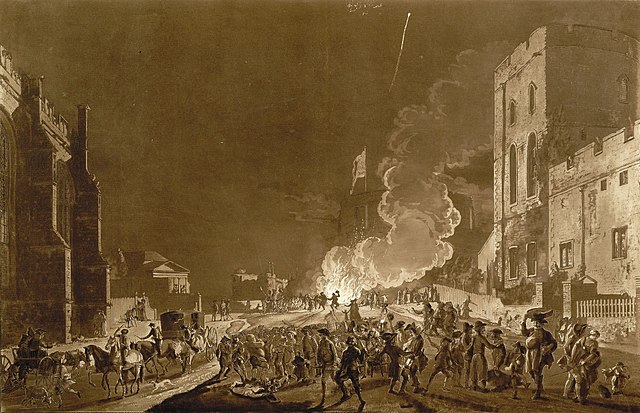
From Wikimedia Commons
Halloween didn't disappear from Europe completely during this time, although its celebration was greatly diminished in many areas. In the British Isles, it was still celebrated in Wales, Scotland, and Ireland (Bannatyne, Halloween, pp. 15). Even in parts of England, the tradition of All Saints' Day and its associated All Hallows' Eve rituals did not completely end. Even though the Church of England didn't officially celebrate the holiday after the reign of Elizabeth I, ordinary Anglicans did quietly continue some of the old practices, and there were Catholics still living in England who maintained their traditions. They continued to light bonfires, ring bells, hold candlelight processions, and go souling (Rogers 27-28). Part of the reason why the tradition of souling continued was because it had become a ritual form of charity at the time of the year when the hardships of winter were just beginning (Rogers 30). These embers of Halloween would take on a new life when settlers from these places made new homes in America.
To TopHalloween Comes to America
Halloween took its modern form in America. When settlers from Europe came to the "New World," they brought their concepts of Halloween with them (Bannatyne, Halloween, p. 16).
Halloween wasn't for everyone in the American Colonies, at least not at first. The people who celebrated it in the early years of the colonies were still the same people who were celebrating it in Europe. The Puritans of New England didn't celebrate many holidays in general, but Catholics in Maryland still celebrated All Saints' Day, All Souls' Day, and Halloween. Members of the Church of England in Virginia, although Protestant, had kept some traditional holidays, including All Saints' Day. The German and Swiss settlers in Pennsylvania had a traditional belief in magic and witchcraft, which would influence the American concept of Halloween. These groups and others would help to create new autumn traditions that would influence the course of Halloween (Bannatyne, Halloween, pp. 21-22).
The New England colonies did not celebrate Halloween but often held festivals in the autumn that celebrated the harvest with corn husking and apple paring (Bannatyne, Halloween, p. 38). Some areas celebrated Guy Fawkes Day. They carved lanterns from pumpkins and held masquerades, traditions that would later move to Halloween as the Guy Fawkes holiday lost favor (Bannatyne, Halloween, p. 39). Maryland, which was heavily Catholic, was the only middle colony which always celebrated All Hallows' Eve, and so did the southern colonies (Bannatyne, Halloween, p. 45).
It was after the Revolutionary War that the celebration of Halloween began to spread. The people in the former colonies, while still from different cultural backgrounds, began to look upon themselves as belonging to a much larger community of Americans, more tied to each other than the places where they were originally from. Public celebrations became more inclusive, less confined to particular groups or churches. The old harvest parties that were meant to add fun and communal aspects to harvest chores developed into larger autumn "play parties," which were meant more for public entertainment than anything else. Play parties were community-oriented and nondenominational (Bannatyne, Halloween, pp. 51 53). Everyone was invited to play parties in the sense that nobody was ever invited specifically. There would just be a general announcement of the time and place which would be passed along by word of mouth, and people in the area would just show up (Bannatyne, Halloween, p. 54). They could take place at any time of the year, but the ones held at the end of the harvest season featured the traditional Halloween foods and activities like apples and nuts, ghost stories, and fortune-telling games. They could also include singing, dancing, and school pageants (Bannatyne, Halloween, p. 53).
These play parties combined with the practices of Halloween in American society. Immigrants from Scotland, Ireland, and northern England brought their traditional Halloween celebrations to America with them (Bannatyne, Halloween, p. 56). Play parties took place in many areas around the country by the middle of the 1800s, and some people used them as part of their Halloween celebration. Halloween itself began to gain popularity among different groups, although it took many years and the influence of new waves of immigrants from Europe for its popularity to spread nation-wide (Bannatyne, Halloween, p. 63). In fact, during the late 1700s and early 1800s, American almanacs didn't mention Halloween as a holiday at all, even though they acknowledged both All Saint's Day and All Soul's Day and the Gunpowder Plot celebrations (Rogers 49).
From Wikimedia Commons
Increasing immigration brought an influx of people with ties to older Halloween traditions. By the end of the potato famine of 1845-1849, approximately 700,000 to 1,000,000 people had come to the United States from Ireland (Morgan 41). Their traditions of "souling" and masquerades contributed to the spread and popularity of Halloween and the practice of trick-or-treating (Bannatyne, Halloween, pp. 66-67). The idea of going from house to house in and begging for coins or food was also familiar to groups who had celebrated Guy Fawkes Day instead of Halloween (Bannatyne, Halloween, p. 71). In addition to the Irish immigrants, Scottish immigrants also brought their Halloween traditions to the United States and Canada. These two groups helped to change perceptions of the holiday from religions ones to ethnic ones. Their traditions, transplanted to the Americas, became reminders not of past quarrels between Catholics and Protestants over views of saints and the pope but of the shared culture of their homelands and fellow immigrants (Rogers 49-51). This view was promoted by the Caledonian societies of Canada, the Irish National League of New York City, and similar groups which organized special Halloween events for their members (Rogers 51-52). Immigrant families celebrated Halloween privately as well as publicly, with one newspaper, the Herald, noting in 1878, "The forests and dells of the United States are too cold and tramp-infested to be thickly populated with fairies and witches, but American ingenuity has devised an acceptable substitute, so if any one failed to see dancing fairies and witches innumerable last evening, it was because he did not make a tour of the parlours of his acquaintances" (Rogers 52-53).
Pranks also became very common on Halloween, thanks in part to Mischief Night traditions from Britain. The pranks were especially popular with boys and young men, and they were pretty creative in their range of tricks (Bannatyne, Halloween, p. 61).
It was about this time, during the late 1800s, that Halloween was beginning to change into the more secular, commercial, public holiday that we know today.
To Top
Victorian Halloween
In the firelight of the farm
Boy and maiden one by one
Place their chestnuts in the grate
And for omens quietly wait;
To a string their apples tie,
Twirl them till they fallen lie;
Those whose fruits fall in a hurry,
They shall be the first to marry.
-- from the poem All Hallowe'en by Pauline Clark, in Ghosts, Witches, and Things Like That by Roderick Hunt.
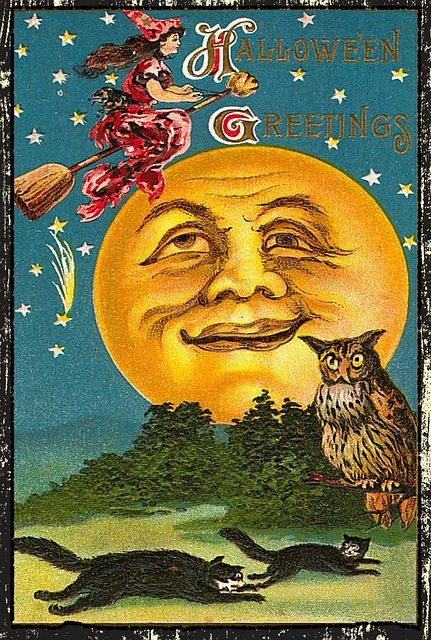
Halloween celebrations were common among Catholic groups and Episcopalians from Scotland in the United States by the time the American Civil War ended. However, the holiday didn't receive much attention from the rest of the nation until it caught the interest of newspapers and magazines which spread the word about Halloween celebrations and gave tips to families for holding their own. The first magazines to promote Halloween as a nation-wide holiday were women's magazines which urged mothers to organize Halloween celebrations for their children. One of the earliest articles aimed at mothers was one in Godey's Lady's Book in 1872 (Morgan 41). With Halloween now being promoted as a family holiday, its popularity grew.
Still, there were some lingering resentments against the holiday for its pagan and Catholic origins and for the destructive element of pranks. In order to make the holiday more acceptable to society in general, the Victorians promoted their own vision of it. When they wrote about the history of Halloween, they focused more on the traditions brought to America from England and Scotland than from Ireland. At the time, there was strong anti-Catholic and anti-Irish sentiment in America because of the influx of Irish immigrants, and people didn't want to think about the influence that the Irish had on the spread of Halloween or the Catholic origins of All Saints' Day and All Hallows Eve. They also wanted to turn Halloween into a much safer holiday, turning the focus away from destructive pranks and the idea of the dead returning to earth. Instead, magazines were full of ideas for throwing Halloween parties: games to play, decorations, food, etc. (Bannatyne, Halloween, p. 104-105). Their ideas were imaginative, invoking the air of mystery surrounding Halloween, but they could safely take place in the parlors of familiar homes, surrounded by family and friends.
Victorian era society in America liked to maintain an image of gentility and rationality. Although, for the most part, Victorians thought of themselves as too sophisticated for superstition, Halloween was one night of the year when they indulged in the old traditional belief of fortune-telling (Bannatyne, Halloween, p. 99, 101). Because of the Halloween traditions of divination, especially superstitions about how to get a vision of your future spouse on Halloween night, more people started throwing Halloween parties with divination games aimed at finding romance, and the holiday became popular with teenagers and young adults (Morgan 41). Their parties also featured kissing games, and hosts would sometimes use mistletoe as a decoration and another convenient excuse for party guests to kiss (Morgan 41).
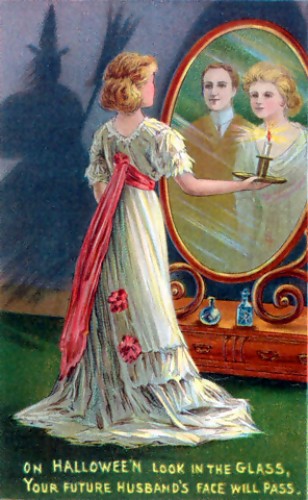
From Wikimedia Commons
Although Halloween became somewhat tamer under the Victorians than it had been, they never succeeded in getting rid of the pranking that had already been a long-standing tradition of the holiday. Pranks were an expected part of Halloween, and neighbors and police typically made allowances for the pranksters. Older boys were the perpetrators of the worst pranks, which they often did late in the night. The public frequently debated about cracking down on acts of vandalism on Halloween (Rogers 57-58). Around the beginning of the 20th century, people were losing patience with the destructive pranks. The police started keeping more of a watch for pranksters, and there were fines imposed on people who caused property damage. Even that wasn't enough to completely discourage pranksters, and the young pranksters even received some sympathy from adults who remembered the pranks they had pulled themselves in their youth (Rogers 59-62). While most holiday celebrations were becoming more organized and respectable with a domestic focus, Halloween was still an opportunity for young people to go a little wild and for everyone to shrug off the usual social inhibitions (Rogers 70).
By the early 20th century, Halloween was no longer viewed as an ethnic holiday, practiced only by people of a certain background or religion. It was now publicly celebrated across North America and there were regular references to it in newspapers (Rogers 67, 69). Halloween also became more commercial as it became more popular. Stores sold increasing numbers of Halloween masks, nuts, and candy (Rogers 53). In general, Halloween was becoming more the holiday that those of us living now are familiar with, but there were some key changes that took place during the 20th century, some of which shaped our own childhoods even beyond Halloween.
To TopHalloween in the 20th Century: Children, Danger, and Imagination
"Spooks and hobgoblins, gypsies and pirates, ghosts in second-best sheets -- they'll be young and not very frightening, but the world is theirs tonight."
-- From the Winnipeg Free Press in 1950, quoted in Halloween by Nicholas Rogers
Safety Concerns
At the beginning of the 20th century, Halloween started shifting into a more secular, commercial form that the general public could celebrate than it had at any other point in its previous history, but people were still struggling to bring some aspects of the holiday under control. Pranks that had been considered traditional for generations were no longer tolerated as much as America became even more urbanized.
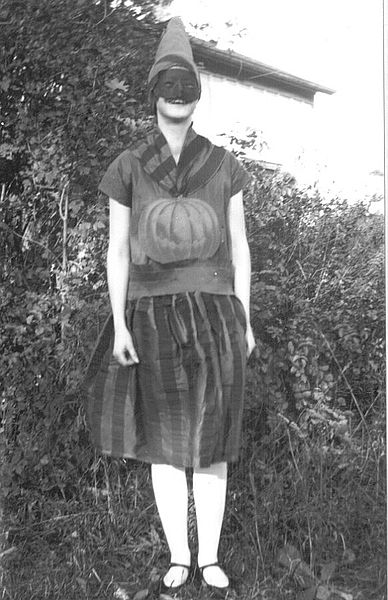
From Wikimedia Commons
The ways that people celebrated Halloween varied dependending on age and gender. During the 19th century, girls and young women mainly enjoyed the tamer party games, while boys mainly enjoyed the chance to go wild and commit a few pranks and some seasonal vandalism with their fellow boys (at least until they were old enough to seek out girlfriends and enjoy a little of the more romantic, matchmaking activities of the holiday). However, with the dawn of the 20th century, more and more Halloween celebrations were sponsored by organized groups, such as schools and churches, and the activities tended to be divided more by age group. It was becoming common for the young children to go out guising or trick-or-treating in the early evening while pranksters were abroad later and young adults went to parties and dances (Rogers 75-76). Part of the reason for the increasing number of organized group celebrations was to cut down on on the vandalism and pranks and give kids a safer way to celebrate the holiday. Communities, civic organizations, and social clubs started offering Halloween carnivals, parades, costume contests, and similar activities for children and dances for teens and young adults (Rogers 80-81).
In spite of this, there were still outbreaks of hooliganism and violence on Halloween night up through the 1930s that were so bad that police had to be called to break up riots. Sometimes, these incidents involved "pranks" that were specifically targeted at certain racial or ethnic groups as people used the excuse of Halloween "fun" to unleash their aggressions on people they already didn't like (Rogers 82-84). Because Halloween was a time when inhibitions were suspended and social conventions turned on their heads, it was a time when the fears and tensions that were present in society all year round could be displayed openly. For one night, people, especially older boys and young men, let themselves lose control on purpose. The attraction of Halloween, for them, was that it was a night when there were no rules. At least, none that they acknowledged.
World War II and the years following it brought changes in attitudes about what Halloween was and what it should be. During and after the war, the charitable aspects of Halloween once again gained attention, and there were more attempts to cut down on the destructive aspects of Halloween by trying to include older boys more in trick-or-treating activities. Trick-or-treating as we think of it now, with children going from door to door in costume to ask their neighbors for treats, started around 1939 in North America and became much more popular in the 1950s. Early on, there was always the very real threat of pranks or vandalism for people who weren't forthcoming with the requested treats, the "trick" part of "trick-or-treat." What the "trick" would be depended on local customs, but property damage in various forms was common and so was the popular soaping of windows (they would take a dry bar of soap and write or draw something on house or car windows). The adults figured that boys would be less likely to want to go out and cause trouble if they were assured of getting treats just for showing up at their neighbors' houses and asking for them. It was only partly sucessful at first. One man, Ray Rheinhart, described the pranks he and his friends pulled as boys saying, "The adult world could not buy us off with candy or shiny pennies. They didn't even try." But over time, especially in the years following World War II, the increased emphasis on Halloween as a day primarily for passing out treats to the young helped to make Halloween even more commercialized. The abundance of new treats, specially designed for Halloween, and the number of commercially-made costumes available during the 1950s and 1960s (much fancier than the homemade costumes from the less affluent years before the war) were more attractive for young consumers. People started reviving the charitable aspects of Halloween, starting with soliciting donations to war-related causes. During the war, children would ask for money to donate to war victims in Britain or to the Red Cross as they trick-or-treated. In the 1950s, the popular cause was the newly-created United Nations. Children then started collecting money for UNICEF (United Nations International Children's Emergency Fund). Under these influences, the "trick" part of "trick-or-treat" gradually started to lose its meaning for many children and became little more than the traditional formula that children would use to ask for the expected treat or charitable donation (Rogers 86-88).
The concerns about safety on Halloween didn't disappear, though. In fact, they only increased as century went on, but with a different focus. In the later decades of the 20th century, the concern became less about protecting property from the pranks and vandalism of wild youths than about protecting young people themselves from people who might use the holiday as a way to harm them. Halloween had never really been considered a "children's holiday" at any point in its history until the 20th century, but during that century, the games and costumes associated with Halloween became associated with the imaginations of children and the traditions of Halloween became a way for children to interact with the rest of society (Rogers 84-85). However, trick-or-treating on Halloween also put children in a position where they depended not just on the generosity of their neighbors but on their trustworthiness.

During the 1960s, stories spread about people purposely giving children tainted candy on Halloween to either harm or kill them. The first story of that nature that was reported in the news involved a dentist in California who supposedly put laxatives in Halloween candy. From there, rumors spread of people putting razor blades in apples and poison or sewing needles in candy. Then, in 1970, something happened to lend strength to the stories: a five-year-old boy died, supposedly of candy that had been tainted with heroin. Later, it was reported that the boy may have actually found a stash of the drug at his uncle's house, not out trick-or-treating. However, other incidents led parents to fear what a derranged person might possible slip into their trick-or-treat bags. Possibly the most famous scare was the death of eight-year-old Timothy O'Bryan, who died after eating a Pixie Stix that had been poisoned with cyanide. It turned out that the poisoner was Timothy's own father, who had murdered his son for the insurance money. Even though this crime had nothing to do with Halloween directly, the fact that the father had used Halloween candy and the rumors of tainted candy to commit his murder heightened parents' fears of the potential for harm to their own children (Rogers 90-91).
News sources capitalized on the fears in their reporting of suspicious incidents, exaggerating the number of incidents while also offering tips to parents for keeping their children safe. In 1975, Newsweek advised parents against allowing their children to accept candy from strangers, especially if the packaging on the treats was damaged in any way. It wasn't that the media had made up the stories about sadism on Halloween so much as they spread already-existing ones more widely, and they weren't always careful about verifying the information that they received, increasing the fears of the general public. In the long run, many of the rumors of sadists harming children on Halloween turned out to simply be "urban legends." While the urban legends had some basic in facts, they were exaggerated out of proportion, became mixed with hoaxes, and led to a panic greater than they really deserved (Rogers 91-94).
The panic caused by these stories caused some parents to simply keep their children home on Halloween. Some communities even banned trick-or-treating, and people increasingly looked for safe, organized activities for their children. Sometimes, shopping malls would offer a version of trick-or-treating, where children would go from store to store and receive items in exchange for coupons. Zoos, museums, and community centers also hosted special Halloween-themed programs. Far less families participated in ordinary trick-or-treating during the 1980s than during previous decades, and many of them restricted their routes only to the houses of people they knew (Rogers 91-93). Part of the difficulty was that, by that point, people didn't know their neighbors as well as in previous decades.
As Rogers notes, people during the 1980s greatly feared that children were much more vulnerable to abuse or molestation or other forms of harm from strangers than they had been in the past (95). Part of the reason was that more mothers were working outside the home than in previous decades and there were more single-parent households. More children were spending time at home after school unsupervised, and people feared that they would be easy prey for evil-minded strangers (Rogers 95).
This part of Halloween's history, I can speak about directly because I was born during the early 1980s, when fears about Halloween were running high. I know that when I was young, although we might know the people who lived immediately next door to us, we didn't know much about the other families who lived just down the block. Adults were often away at work all day, both men and women, and when they got home, they were more likely to watch tv and spend time with their own families than associating with the neighbors. It wasn't strange because that's pretty much what every family did then. It was kind of like we all lived in small bubbles, little pockets of friends and acquaintances in the neighborhood, with big gaps in between. It left us all with the feeling that we were living in close proximity to strangers who could be anyone and who might do anything when the kids came around on Halloween.

When I was a child in the late 1980s and early 1990s, I was allowed to trick-or-treat in the neighborhood, but the adults always gave us warnings about going to the houses of strangers.One of the ways we helped to protect ourselves and each other was by trick-or-treating in groups, often with an adult escort until we were a little older. One of the nice aspects of going as a group, besides having all of your friends along, was that, even if you didn't know very many people in the neighbhorhood by yourself, other people in the group would know more, so you were able to go to more houses and still feel like you weren't visiting complete strangers. From there, some of us simply took our chances. When you'd almost made it to the end of the block, and there were just a couple of houses left, even if you didn't know those people, what's one or two more? In reality, it probably wasn't as much of a risk as we sometimes felt like it was, but we always checked over anything we'd received in case of tampering. What we got were almost exclusively individually wrapped candies, most from widely-recognized major brands. Gone were the days of homemade popcorn balls and candy apples that our parents remembered from the 1950s! No one handed out homemade treats. If we'd received anything homemade at all, our parents would have thrown it out over concerns for our safety. The only remnant of that earlier time that I can remember was my grandmother, who gave out pennies to trick-or-treaters, whether they were collecting for anything or not. Everything else was prepackaged, and if we found something in our bags with a damaged wrapper or anything without a recognizable label, we dutifully threw it away. (It was decades later that I finally figured out that those mysterious pieces of candy in the black and orange wrappers were Mary Janes, not something weird cooked up by a sadist. Or maybe they were. Mary Janes are hard enough to break your teeth.)
Rogers points out that Halloween in the 1950s (the Halloween of my parents' childhoods) probably wasn't quite as safe as it appeared by later standards, but there was the perception that it was. Society in general was more stable in the 1950s, or seemed so on the surface. There were much lower divorce rates, and most children lived in two-parent households with mothers who were available for their children full time because they didn't have other jobs (Rogers 101). This was before the economic problems caused by deindustrialization in the late '70s and early '80s (Rogers 98). It was before the Civil Rights Movement with the accompanying riots. Society and politics changed radically in the United States during the '60s and '70s. Crime rates related to drugs and gangs also increased (Rogers 94-95). Although those of us who were born in the 1980s couldn't remember a time before these changes occurred, our elders did. For them, the world had become a less prosperous and more dangerous, unpredictable place. It was frightening, and perhaps not so unpredictably, those fears spilled over into the holiday that had become dedicated to celebrating fear. When they heard the stories of people harming children on Halloween, they were prepared to believe them as just an extension of the chaotic and frightening times they lived through.
Still, all the fear wasn't enough to put an end to Halloween. In the new millenium, children who grew up with adults' fears of Halloween became adults themselves and have found ways to perpetuate the holiday for themselves and their children.

The Commercialization of Halloween
Even early in the 20th century, symbols of Halloween were becoming more standardized and commercial. Stores, restaurants, and offices started puting up Halloween decorations which almost uniformly featured the colors orange and black (or sometimes yellow and black) and now included bats and black cats in reference to their association with folklore about witchcraft. They were not considered part of Halloween before that, although their connection to the supernatural was promoted by Gothic fiction during the 19th century. Other common decorations included ghosts, jack o'lanterns, witches, and harvest symbols (Rogers 76). There were also an increasing number of books that people could use as references when planning Halloween parties, filled with ideas for games and icebreakers that were sometimes variations on traditional ones and sometimes new with little or nothing to do with the old traditions (Rogers 75-76).
This is when trick-or-treating also became the popular tradition that we know today, partly as an effort to make Halloween safer for communities and more child-appropriate. With larger numbers of children roaming the neighborhoods in search of sweets on Halloween night, the candy industry benefited enormously, coming out with new varieties of Halloween candy. In the prosperous 1950s, this tradition reached its height, and more children also began wearing commercially-made Halloween costumes instead of the homemade variety that they'd used before (Rogers 86-88). Later, this would lead to criticism that Halloween's new purpose was to turn children into little consumers, going from door to door with their "shopping bags" (Rogers 160).
Halloween Entertainment

From Wikimedia Commons
The film and movie theater industries didn't immediately see or take advantage of the connection between Halloween and scary or supernatural themes in movies. Rogers puts it that, "Halloween parties of the 1930s might occasionally feature tales from the high Victorian Gothic, but the accent of most of them was on Halloween hilarity, not horror." When Dracula with Bela Lugosi came out in 1931, it was released on Valentine's Day, not Halloween. However, things changed toward the end of the 1930s when Orson Welles did his famous radio broadcast of The War of the Worlds on October 30, 1938. Because the story was presented as a series of news broadcasts that supposedly cut into a regularly scheduled program of music, some people who tuned into the program late and didn't realize what they were really listening to believed that the news broadcasts were real and panicked, thinking that aliens from another planet had actually invaded Earth. This unintentional Halloween scare called attention to the connection between Halloween and fear and helped the commercial entertainment industries to realize that they could benefit from promoting horror around Halloween (Rogers 106).
The connection betwen Halloween and the horror genre strengthened throughout the 20th century. By the '60s, it was becoming common for television stations to show classic horror films around Halloween. During the 1970s, movies theaters were following suit in their Halloween offerings, and the range of horror offerings on tv increased (Rogers 107-108). Horror films also began growing more graphically violent. The movie "monsters" turned more to serial killers, insatiable killing machines that were often only defeated temporarily, returning to kill again and again in merciless, bloody fashion, whereas the villains in earlier films were usually defeated by the heroes in the end. These new, more violent, bloodier movies were especially popular with adolescent boys (about the same age group that had been a source of major concern about Halloween pranks and vandalism in earlier decades), and adults became concerned about the effect that these movies would have on the young (Rogers 108-109). In a way, the changes in the movie industry reflected changes in society and communal fears at the time as rumors spread about disturbed individuals harming children on Halloween. Frightened parents could easily imagine that people who were otherwise invisible members of society, strangers with derranged minds and evil intentions, could kill simply by slipping poisoned treats into an innocent child's trick-or-treat bag that would be next to impossible to trace later. When it came to horror, what could be more frightening than the prospect of a human monster who might live just around the corner, untraceable and unstoppable?
However, people continued to crave scary movies and attractions even more after rumors of Halloween sadism began scaring people away from trick-or-treating (Rogers 104). It seems that the "safe scares" of the entertainment world such as horror movies and haunted public attractions filled a need for people who were frightened of the prospect of human monsters who might be living in their own neighborhoods. The popularity of public haunted houses and similar attractions rose during the 1980s, starting with smaller ones at local community centers and city parks and then leading to large commercial haunted houses that catered to thousands of people during a single two- or three-week run around Halloween (Rogers 104-105).
Costumes also became much more central to the celebration of Halloween, for adults as well as children. There were plenty of parties, parades, and dances at Halloween in the early part of the 20th century, but they took on a new life during the '70s as society became more permissive on the subjects of alcohol and styles of dress. Adults started to feel more free about self-expression. Rogers quotes a librarian as saying, "You have to follow rules in everyday [life], but on Halloween you can dress up according to your fantasy." For some people, it meant variations on the traditional Halloween ghosts, witches, and monsters, but more and more, people based their costumes on characters from movies and television shows (Rogers 127-129). People dressed up as things or characters that appealed to their imaginations or that made some more personal statement about themselves and how they wanted to be seen. Sometimes, they used costumes to make statements about society and modern culture, pointing at important issues of the time (Rogers 129-130). Homosexuals in particular used Halloween as an opportunity to show off sides of their personalities which weren't accepted so easily at other times of the year (Rogers 132). Because of the imaginative, playful qualities of Halloween, it allowed people to live their fantasies in a way that they couldn't otherwise without suffering social stigma (Rogers 137). Through playing "pretend," people could make certain realities about themselves more socially acceptable and find a little release from the tensions of everyday life.
To TopModern Halloween in the New Millenium
Even a man who is pure at heart
And says his prayers at night
Can become a wolf when the wolfbane blooms
And the Moon is full and bright
-- Curt Siodamak, The Wolf Man, Universal Pictures, 1941, quoted in The Real Halloween by Sheena Morgan, p. 58.
Nicholas Rogers, author of Halloween: From Pagan Ritual to Party Night, says that "Halloween at the millenium is a contested and in many respects a controversial holiday." The view of Halloween as a holiday for children with trick-or-treating and a chance to exercise youthful imaginations is still popular and, in fact, has increased in popularity since the scares of Halloween sadism (Rogers 158-159). Still, Halloween has met with criticism that it's far too commercial and just encourages children to become little consumers, out shopping for the best candy. There have also been religious concerns as Christian fundamentalists disapprove of the holiday's pagan origins. Some of them have tried to ban Halloween altogether in certain areas, while others simply discourage children from dressing as anything that seems to promote satanism, such as witches and devils (Roger 160). It's still fairly early in the 21st century, so it's difficult to say for sure what course Halloween will take as the century moves on, but there are some aspects of the holiday what will probably hang on because they have already lasted for centuries, in one form or another.
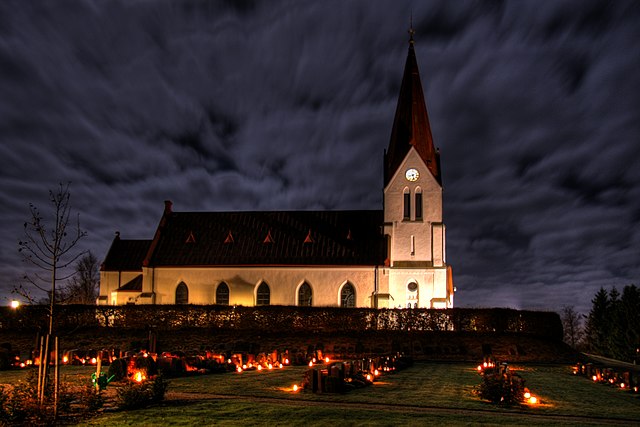
From Wikimedia Commons
If you ask people today what Halloween is, you'll get a variety of answers, but if you read through all the other sections on Halloween's history, you'll realize that none of those answers are anything new, and some of the controversies surrounding Halloween are echoes of ones that date back centuries. Even people who disapprove of Halloween for its pagan origins have had plenty of historical company in the form of early Christians, who sought to use it for their own purposes, and early Protestants, who wanted to eliminate it from the calendar as they struggled to establish a new focus for religion that did not rely on old traditions. Most commonly today, people talk about memories of trick-or-treating for candy as children wearing costumes. The children who do this today may not know anything about the souling and soul cakes of the early Christian Celts in Europe or how that tradition started as a way to bring Halloween more in line with Christian values than with earlier pagan practices. Adults go to costume parties with special food and drink, enjoying the excuse to party and "let loose" a little, not really thinking of them as echoes of the parties held for centuries at this time of year. There are public Halloween festivals with harvest themes, corn mazes, haunted houses, and sometimes fortune-telling, which aren't as far from older harvest festivals as you might suppose. Even the horror movies that we watch on tv on Halloween night are just another spin on much older ghost stories that people would tell around the family hearth. Where they differ depends on the fears that haunt the minds of people in modern times, which aren't in quite the same spirit as the scary tales of the past.
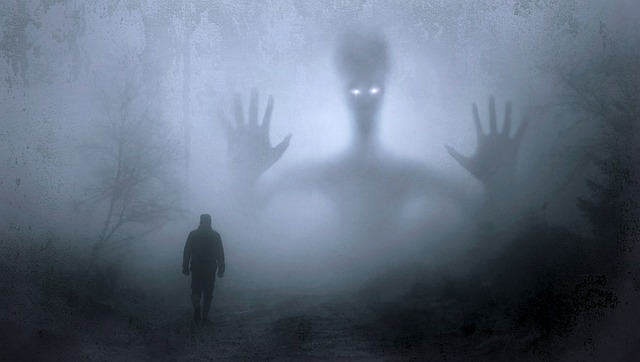
The reason why Halloween has survived, in one form or another, through so many centuries, is because it speaks to so many people in different ways. The more serious side of Halloween is the need to remember the past, particularly remembering the spirits of dead, of people we once loved and who loved us. There is always that part of us that likes to think that they've never really left us, that they might return once in awhile, even for a brief time, just to share in our lives and to remind us that they are still there. There is less emphasis on this aspect of Halloween in modern times, but some of that spirit still remains in the sense of mystery that Halloween inspires. It is no accident that Halloween comes with the changing of the seasons, when the weather turns colder, the nights are growing longer, and we know that we will be spending more of our time in darkness. Who knows what lurks in the shadows? What is waiting for us in a future that we can't see? Even with our modern technology, there are aspects of life and death that no one really understands. Halloween reminds us of the unknowns that we all face, but it's also in the context of something familar, a tradition that has been celebrated for many generations, which makes facing the unknown less frightening. We're doing it together, just as so many have done before us . . . and, you know, it's really kind of fun, isn't it?
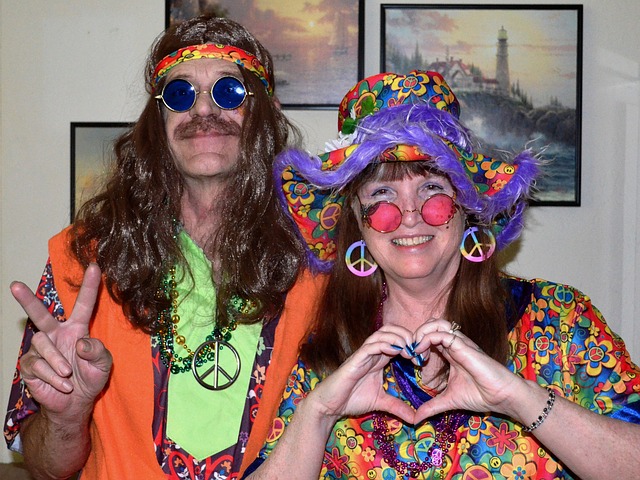
On the lighter side, Halloween is a time to let our imaginations run wild and to indulge in a little fantasy. You can put up wild decorations and turn your house into a haunted house. With the costume of your choice, you can be anything you want for one night of the year. You can show off your creative side by coming up with something unique, live out a dream (or a nightmare), or even use your costume to make a statement. Some of the usual inhibitions are temporarily suspended, and for one night, you can eat too much candy, party with your friends or total strangers, and maybe even flirt a little. It's a time when you can be a little daring, but all the while, you know that you're not that far from the safe and familiar. If you visit a public haunted house or watch scary movies, your friends and family will all be there with you, sharing the experience.
To Top

